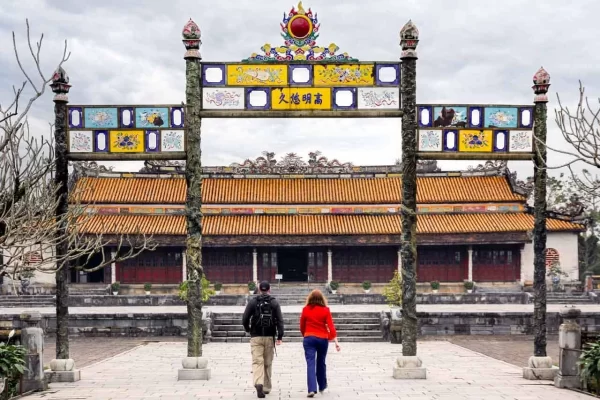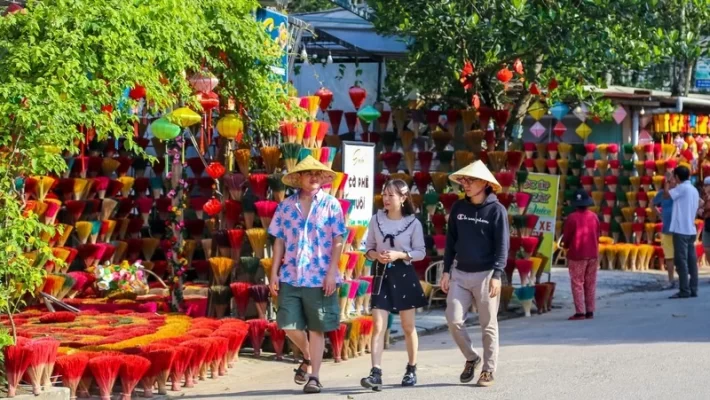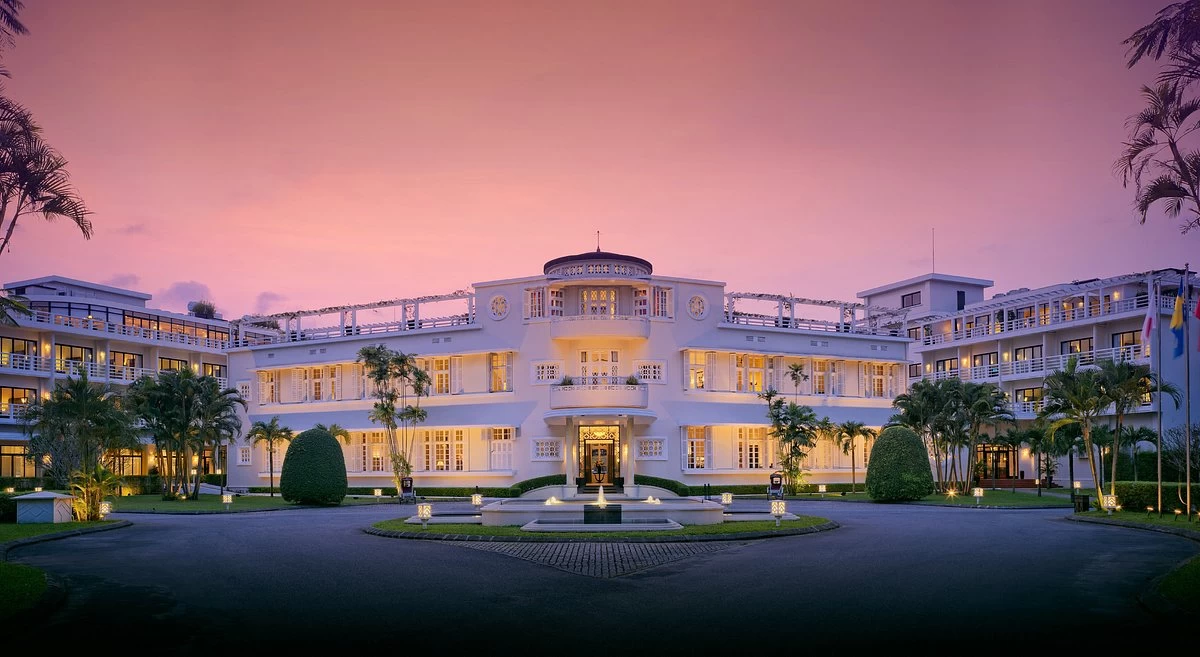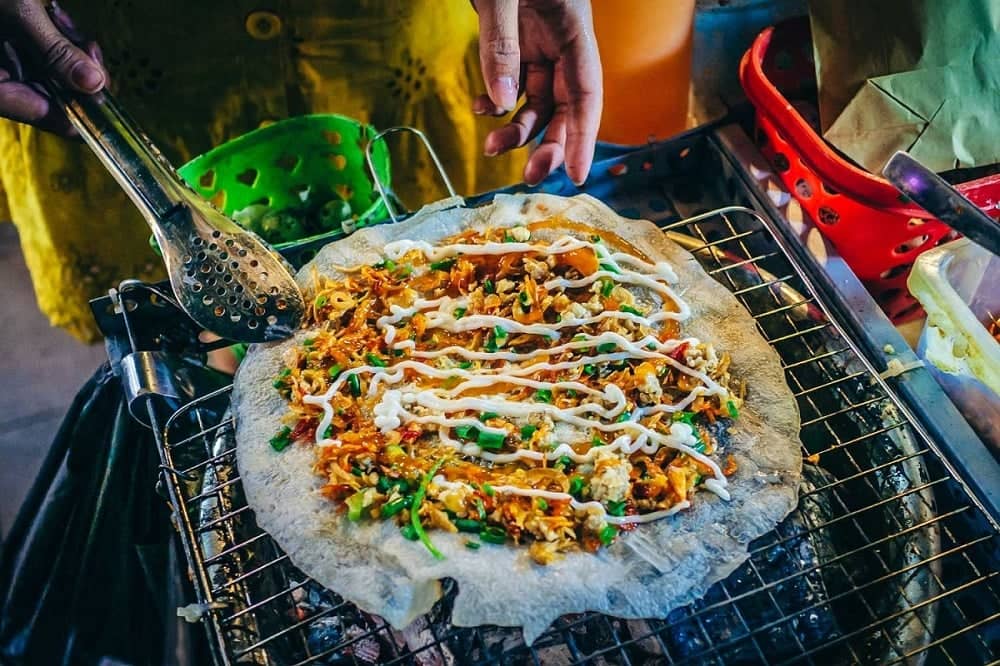
Let’s discover the best things to do in Hue!
Discover the best things to do in Hue. Explore the historic Imperial City of Hue, marvel at the intricate tombs of the Emperors, and enjoy a serene boat ride on the Perfume River. Immerse yourself in local culture with a visit to Dong Ba Market and experience traditional Hue cuisine with our top dining recommendations. Whether you’re wandering through ancient pagodas or relaxing on Lang Co Beach, Hue offers a rich tapestry of history, culture, and natural beauty waiting to be explored. Follow Ula Travel now!
I. Overview of Hue
Once the capital of Vietnam during the Nguyen Dynasty from 1802 to 1945, Hue boasts a treasure trove of historical landmarks and well-preserved architecture that transport visitors back in time. The city is renowned for its majestic Imperial City (Citadel), which showcases the grandeur of Vietnam’s royal past. With its ancient temples, pagodas, and tombs, Hue stands as a living museum of traditional Vietnamese culture and history.

Hue is a destination rich in cultural and historical values.
The Imperial City of Hue, a UNESCO World Heritage Site, is an expansive complex of palaces, temples, walls, and gates, reflecting the opulence of the Nguyen emperors. The city’s historical significance is further highlighted by the beautifully adorned tombs of various emperors, each set in serene landscapes that combine architectural splendor with natural beauty.
Additionally, Hue’s vibrant cultural scene includes traditional festivals, crafts, and culinary delights that make it a captivating destination for anyone interested in Vietnam’s rich heritage.
II. Historical and Cultural Sites in Hue
1. Imperial City of Hue
The Imperial City of Hue is a majestic historical complex that served as the political and cultural center of the Nguyen Dynasty from 1802 to 1945. This UNESCO World Heritage Site is renowned for its grand architecture and rich historical significance.

Imperial City of Hue
The Imperial City is enclosed within a massive fortified wall, creating a city within a city. The complex features a series of grandiose structures, including the Forbidden Purple City, the central administrative and ceremonial hub where the Emperor and his family resided. The design reflects the traditional principles of Feng Shui and incorporates elements of Confucianism and Daoism.
Are you looking for Hue tours?
2. Minh Mang Tomb
The Minh Mang Tomb is one of the most impressive and historically significant royal tombs in Hue. Built between 1840 and 1843, it serves as the final resting place of Emperor Minh Mang, the second ruler of the Nguyen Dynasty. The tomb is renowned for its harmonious blend of architectural grandeur and natural beauty.

Minh Mang Tomb
The tomb complex is set amidst a picturesque landscape, incorporating both man-made structures and natural elements to create a serene and majestic atmosphere. It is designed with a symmetrical layout that reflects the principles of traditional Chinese architecture.
Start your journey with: Discover Central Vietnam Tour in 6 Days
3. Khai Dinh Tomb
The Khai Dinh Tomb stands as a striking representation of the fusion between Eastern and Western architectural styles. Constructed between 1920 and 1931, this tomb is the smallest yet the most elaborate among the imperial mausoleums in Hue. Unlike the traditional large-scale layout of previous emperors’ tombs, Khai Dinh’s tomb is built on a hillside with a steep staircase leading to the main structure, giving it a compact but imposing presence.

Khai Dinh Tomb
What makes Khai Dinh Tomb particularly remarkable is its intricate decoration and use of materials. The tomb is adorned with a mosaic of ceramics and glass fragments, creating vivid patterns that reflect the emperor’s taste for opulence. Inside the main building, visitors can marvel at the Thien Dinh Palace, where the emperor’s statue and altar are located.
The ceiling is painted with intricate, European-style frescoes, depicting scenes of dragons in the clouds, showcasing a blend of traditional Vietnamese art with Western elements. The entire structure is a testimony to Khai Dinh’s personality and his desire for grandeur, blending both Gothic and Renaissance architectural influences with Vietnamese traditions.
Read more: Da Nang to Hue – Unexpected Trip You’ll Love
4. Tu Duc Tomb
The Tu Duc Tomb is a tranquil retreat that reflects the emperor’s poetic soul and love for nature. Constructed between 1864 and 1867, this tomb served as both a resting place and a retreat during Tu Duc’s lifetime. Spanning a vast area, the tomb complex is surrounded by walls and includes a range of structures like palaces, pavilions, and temples, each carefully positioned to harmonize with the surrounding landscape.

Tu Duc Tomb
One of the tomb’s highlights is Luu Khiem Lake, a serene body of water that adds to the peaceful atmosphere of the site. The emperor used this lake for boat rides and to admire the scenic beauty of the area. Across the lake lies the Xung Khiem Pavilion, a place where Tu Duc would compose poetry and reflect on his reign.
More details: Best Day Trip from Hue to Phong Nha for Your Vacation
5. Thien Mu Pagoda

Thien Mu Pagoda
Thien Mu Pagoda is one of Hue’s most iconic landmarks and a symbol of the city’s rich spiritual heritage. Perched on the northern bank of the Perfume River, the pagoda dates back to 1601, when it was originally established by Lord Nguyen Hoang, the first Nguyen lord of southern Vietnam. Over the centuries, it has undergone various renovations and expansions, making it not only a place of worship but also a repository of historical and cultural significance.
III. Natural Attractions in Hue
1. Perfume River

Perfume River
The Perfume River is the lifeline of Hue and one of its most enchanting natural attractions. Stretching approximately 80 kilometers, it flows serenely through the city, dividing it into two distinct halves and offering a stunning backdrop to many of Hue’s historical sites. The river derives its name from the fragrant aroma that arises from the lush orchards along its banks, particularly during autumn when flowers bloom and their scent wafts into the water.
Visitors can experience the charm of the Perfume River through a variety of activities. One of the most popular is a boat cruise. Traditional dragon boats, richly adorned with intricate designs, take travelers on a leisurely journey along the river.
2. Hai Van Pass

Hai Van Pass
The Hai Van Pass is often referred to as one of the most scenic routes in Vietnam. It stretches about 21 kilometers and winds through the Annamite Range, offering breathtaking views of the coast, mountains, and verdant forests. The name “Hai Van” means “Ocean Cloud,” a fitting description for this pass where the road seems to touch the sky, often shrouded in misty clouds that meet the turquoise waters of the East Sea below.
The journey across the pass is not just about the destination but the thrill of the road itself. Whether you’re riding a motorcycle or driving a car, the sense of adventure and the natural beauty surrounding you make it a must-do activity for those visiting Hue.
Click here: Central Vietnam Wonders Tour
3. Lang Co Beach
Lang Co Beach is a pristine coastal paradise that captures the essence of Vietnam’s natural beauty. This crescent-shaped bay stretches for about 10 kilometers, with powdery white sand framed by crystal-clear waters on one side and lush green mountains on the other. Its idyllic setting, combined with a laid-back atmosphere, makes it a favorite destination for both relaxation and adventure.

Lang Co Beach
Lang Co Beach is perfect for those looking to unwind in a serene environment. The gentle waves and shallow waters make it ideal for swimming, while the soft sands invite you to lie back and bask in the sun. For those seeking more active pursuits, the beach offers a range of water sports, including jet skiing, windsurfing, and snorkeling. The clear waters are teeming with marine life, and a snorkeling excursion reveals vibrant coral reefs and schools of tropical fish.
IV. Local Markets and Craft Villages in Hue
1. Dong Ba Market
Dong Ba Market is one of the oldest and most famous markets in Hue, offering a vibrant and authentic glimpse into the daily lives of the locals. Located near the northern bank of the Perfume River, this bustling market is a treasure trove of cultural and culinary experiences. Spanning several floors and covering a vast area, it features an array of stalls selling everything from fresh produce and seafood to local delicacies and handmade crafts.

Dong Ba Market
What makes Dong Ba Market unique is its atmosphere—it’s a place where the past and present of Hue converge. The lively ambiance, the call of vendors, and the colorful display of goods reflect the city’s vibrant culture. Engaging with local sellers, many of whom have been trading here for generations, offers a deeper insight into the region’s customs and way of life.
2. Craft Villages in Hue

Sinh Village
One of the most famous craft villages is the Sinh Village, renowned for its folk paintings. This village has a long-standing tradition of creating folk art that is deeply rooted in Vietnamese culture. The paintings are characterized by their vibrant colors and depict various themes such as daily life, myths, and festivals. These works of art are made using natural materials like woodblocks and traditional paper, ensuring that each piece is unique.

Phuoc Tich Pottery Village
Another notable village is the Phuoc Tich Pottery Village, known for its ceramics and pottery. Phuoc Tich has been producing high-quality pottery since the 15th century, and its products are highly valued for their simplicity, durability, and elegant designs. Guests can also participate in pottery classes to create their own ceramic pieces, providing a hands-on cultural experience.

Thuy Xuan Incense Village
Thuy Xuan Incense Village is another must-visit destination, where the air is filled with the fragrant scent of incense. Here, visitors can observe the intricate process of incense-making, from mixing aromatic powders to hand-rolling and drying the sticks. The village is especially colorful, with hundreds of incense sticks in various shades of red, yellow, and purple displayed in front of the workshops.
V. Culinary Experiences in Hue
1. Hue Cuisine
Here are some of the must-try dishes that define Hue’s unique cuisine:

Bun Bo Hue
- Bun Bo Hue: This is perhaps the most famous dish from Hue. Bun Bo Hue is a hearty beef noodle soup known for its rich, spicy broth, flavored with lemongrass, shrimp paste, and chili. The soup is typically served with thick rice noodles, tender slices of beef, and pork hock. It’s garnished with fresh herbs, lime wedges, and bean sprouts, giving it a vibrant and refreshing contrast to the broth’s deep flavors.
- Banh Khoai: A savory Vietnamese pancake, Banh Khoai is made from a batter of rice flour, turmeric, and water, resulting in a crispy, golden exterior. It’s filled with shrimp, pork, and bean sprouts and is often served with fresh herbs and a tangy dipping sauce made from peanut and fermented bean paste.
- Nem Lui: These lemongrass skewers are a favorite among locals and visitors alike. Nem Lui consists of seasoned ground pork wrapped around stalks of lemongrass, grilled over an open flame until slightly charred and smoky. The skewers are served with rice paper, fresh herbs, and a variety of raw vegetables.
Read more: Best Restaurants in Hue
2. Cooking Classes in Hue

Thuy Bieu Eco-Village
- Thuy Bieu Eco-Village: Situated in a serene rural area near Hue, Thuy Bieu offers an immersive cooking class that begins with a market tour. Participants get to select fresh ingredients while learning about the variety of herbs, spices, and produce used in Vietnamese cooking. Back at the village, you will learn to prepare traditional dishes such as Bun Bo Hue, Banh Khoai, and spring rolls, all under the guidance of skilled local chefs.
- Hue Cooking Class: Located in the heart of Hue, this class provides an intimate cooking experience with a focus on authentic, home-style dishes. The session often starts with a guided visit to Dong Ba Market, where you’ll gain insight into the local food culture. Then, in a cozy kitchen setting, you’ll learn to create dishes like Nem Lui and Banh Khoai from scratch. The instructors share not only the recipes but also cooking techniques and cultural stories behind each dish.

Hue Eco Cooking Class
- Hue Eco Cooking Class: This class offers a more holistic culinary experience by combining cooking with a cycling tour through the city’s picturesque countryside. You’ll visit a local market, learn about the ingredients, and then cook a multi-course meal featuring classic Hue dishes. The class is perfect for those who want to explore Hue’s natural beauty while learning about its culinary arts.
Read more: Top 4 Cooking Classes in Hue
VI. How to Discover the Best Things to Do in Hue
1. Getting Around Hue
- Taxis: Taxis are a convenient option for tourists who prefer comfort and ease of travel. They are readily available and can be hailed on the street or booked via phone or ride-hailing apps.
- Motorbikes: Renting a motorbike is a popular choice for those who want to explore Hue at their own pace. It allows greater flexibility and is often the preferred method for reaching less accessible areas. Motorbikes can be rented from various local rental shops in Hue. Prices typically range from $5 to $10 per day.
- Bicycles: For a more leisurely exploration, renting a bicycle is a great option. It’s an eco-friendly way to get around and allows you to enjoy the scenic beauty of Hue. Many hotels and guesthouses offer bicycle rentals, or you can rent from local shops. The cost is usually around $2 to $5 per day.
2. Best Time to Visit Hue
Peak Tourist Seasons:
- High Season: The dry months, especially from June to August, are the busiest with tourists. Attractions are more crowded, and prices for accommodation and flights can be higher.
- Low Season: The wet season sees fewer tourists. This can be a good time for budget travelers, although some outdoor activities might be limited due to weather conditions.
Festivals and Events:
- Hue Festival: Held every two years, typically in April, this cultural event features traditional music, dance, and art performances, making it a vibrant time to visit.
- Tet: Celebrated around January or February, Tet is the Vietnamese Lunar New Year and is an excellent time to experience local traditions and festivities.
Learn more about: Hue Weather
In conclusion, Hue is a destination that encapsulates the essence of Vietnam’s rich history, culture, and natural beauty. From the ancient Imperial City of Hue and magnificent royal tombs to the serene Perfume River and picturesque beaches, Hue offers a diverse range of experiences for every traveler. Its unique blend of historical landmarks, culinary delights, and traditional crafts provides an immersive journey into the heart of Vietnam’s heritage.
Whether you are a history enthusiast, a nature lover, or a food connoisseur, Hue promises an unforgettable experience. Make sure to include this charming city in your travel itinerary to truly appreciate the cultural depth and scenic beauty that Vietnam has to offer.
See more: Hue travel tips



























